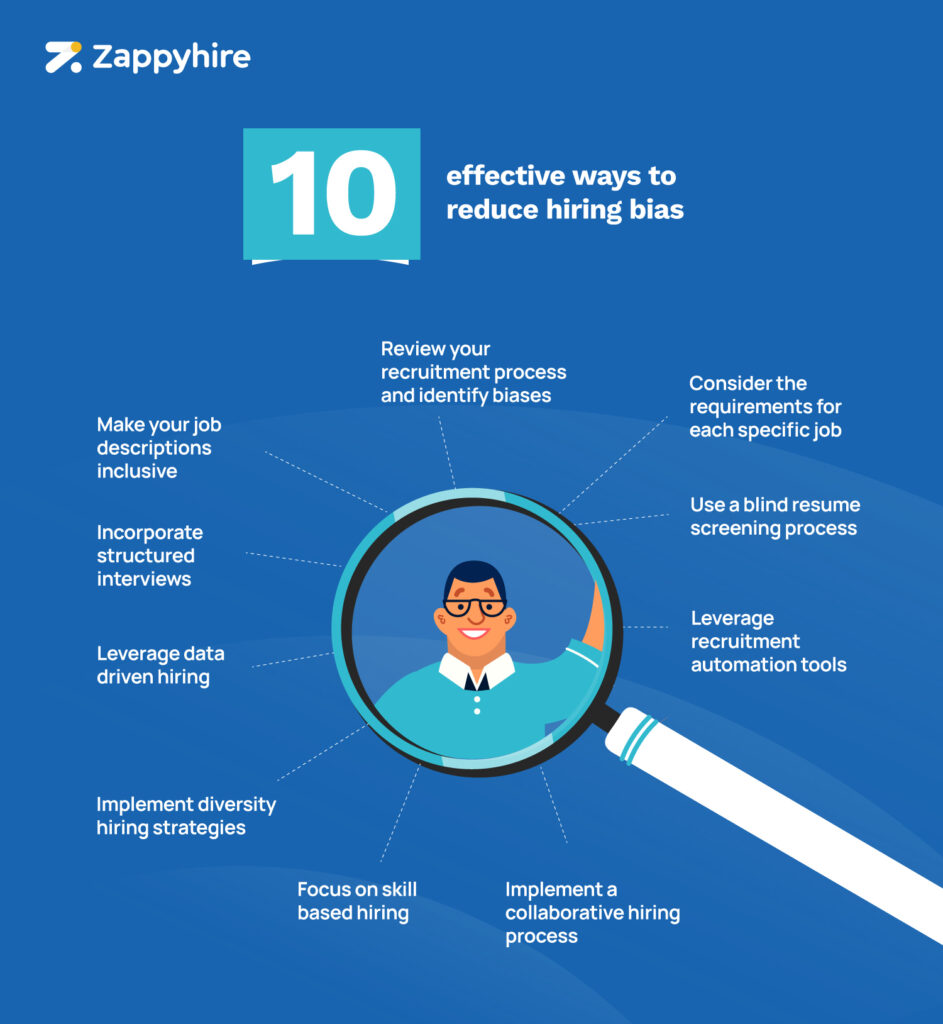
Imagine overlooking top talent because of reservations members of a hiring team have against certain candidates owing to prejudices or preconceived notions? What a monumental loss for the organization, right?
Unfortunately, this happens way more than you think – 48% of HR managers admit that bias has impacted their choice of candidates!
Let’s be real, hiring bias isn’t just unfair and unethical, it also negatively impacts an organization’s performance, owing to poor quality of hires and reduced diversity.
What’s crucial, is to identify and tackle these biases that plague the hiring process.
By using well-formulated strategies organizations can promote fairness and ultimately drive organizational success!
Up for a deep dive into these strategies? Let’s go!
10 effective ways to reduce hiring bias

Are you aware that nearly three-quarters of candidates have witnessed discrimination in the recruitment process?!
To illustrate how random, uninformed, and baseless these biases can be, consider this example: Members of the hiring team may overlook women with children, wrongly assuming they won’t be as dedicated to the role as a man.
What makes it worse is that many of these biases operate at an unconscious level, beyond the recruiter’s control, which is a major challenge for them to tackle.
This brings us to the question – can implementing effective strategies really help?
The answer is YES! While it may not completely rid your hiring process of bias, it’s a strong starting point for improvement. On that note, let’s delve into 10 effective steps to reduce bias in hiring–
1. Review your recruitment process and identify biases
First things first! You’ve got to know where the issue lies and understand its nuances to be able to solve it! Ask yourself-
- Are your recruitment processes riddled with instances of hiring bias?
- At which stages do these biases tend to creep in?
- Are you familiar with the different types of hiring biases, and can you recognize them in your own processes?
It’s imperative that organizations frequently review their recruitment practices, analyze records and data, and identify trends or patterns that may point to bias in decision-making.
Once you’ve figured out the whats, whys, wheres, and whens, it’s much easier to move onto the next step: the real battle, i.e., implementing strategies to combat these biases.
💡 Check out our blog, 10 Types of Hiring Biases Recruiters Should Be Aware of, to effectively identify and label these biases in your recruitment process.
2. Consider the requirements for each specific job
When you clearly define what exactly you are hiring for, it’s easy to sketch out a clear picture of the ideal candidate for that role.
Each role is unique and comes with its own specific demands, so using generic parameters to assess candidates won’t cut it.
It’s crucial to prepare a candidate persona that specifically highlights the skills, qualifications and traits that the perfect candidate for the role in question must possess to thrive in a role.
This brings in objective criterion into the picture, that makes it harder for biases to seep into the process.
Recruiters would now have a blueprint of what exactly to look for, not some vague abstract idea of an ideal candidate which makes room for subjectivity and thereby biases.
3. Make your job descriptions inclusive
Bias can creep into the process surprisingly early, often at the job description stage.
How does this happen? If members of the hiring team have preconceived notions about the ideal candidate, this can reflect in the language being used.
Consider the following sentence, a simple example of how language used in job descriptions can reflect biases –
“The successful candidate will bring his vast experience and technical expertise to lead turnkey projects, ensuring its timely execution”.
The usage of such gendered pronouns immediately discourages candidates of other genders from applying, depriving the organization of promising talent.
This is also applicable when age-related specifications or specific educational backgrounds, etc., are specifically mentioned.
To avoid this, use gender-neutral terms, avoid specifying or implying age requirements or irrelevant qualifications, and ensure the focus is on skills and competencies only.
This is the first direct touchpoint between you and potential candidates, so make sure it counts and is inviting to all!
💡 Discover how to create the perfect job description with : The Ultimate Job Description Toolkit.
4. Use a blind resume screening process
No matter how hard you try, it is not possible to decrease the chances of biases creeping into your recruitment processes by 100%.
Let’s take the case of when resumes are analyzed.
This is the first touchpoint where the hiring team forms opinions about the candidates, which can either (unfairly) work in their favor or against them.
It is crucial to incorporate blind screening processes, by which we mean recruiters review resumes “blind”.
This means there is zero hint of the candidate’s name, gender, age, race, or any other information irrelevant to the job in question that could influence the recruiter’s opinion.
Leveraging resume parsers can also do wonders in this case by minimizing human involvement and thereby reducing the chances of bias influencing the decision.
5. Leverage recruitment automation tools
Leveraging recruitment automation tools can have a large number of benefits that drive organizational success, and one such advantage is the significant reduction of biases in hiring!
When you adopt these tools that offer AI assessments, automated video interviews, resume parsers, etc., for pre-screening processes, you can drastically reduce instances of biased hiring decisions as they minimize human intervention.
They help assess candidates objectively, based on their skills and qualifications, as opposed to subjective impressions.
It also facilitates standardized processes and consistent evaluations, ensuring that all candidates are assessed against the same criteria, ensuring that the hiring process is more fair and transparent.
6. Incorporate structured interviews
It’s not uncommon to encounter interviews where one candidate is asked easier questions to increase their chances of getting the job, while another faces tougher questions due to an interviewer’s prejudice.
The interviewer holds the reins and can very easily influence how the interview pans out ultimately.
But structured interviews have emerged as the antidote to this issue!
By definition, structured interviews involve interviewers using a predetermined set of questions for every candidate.
This ensures that all candidates are evaluated consistently, plus, with the focus on technical skills, behavioral competencies, and other criteria required for the role.
When all candidates are asked the same set of questions and are assessed against the same criteria, it removes the subjectivity out of the interview process, and the most deserving candidate is hired!
💡Curious to learn how structured interviews are conducted? Check out our blog: How to Conduct a Structured Interview.
7. Leverage data-driven hiring
Being hyper-aware of the ground reality is more than crucial, and only data can provide that unfiltered perspective.
While you may believe your hiring process is bias-free, only hard data can give you an accurate picture of the situation.
Consider leveraging data-driven recruitment practices that use data analytics and crucial insights, to significantly enhance the hiring process.
This approach helps you track trends and patterns over time, allowing you to identify specific types of bias that may exist in your recruitment operations.
By analyzing metrics such as candidate drop off rate by demographic, diversity of the candidate pool, diversity among new hires, interview to offer ratio, etc., you can identify biases and develop strategies to address the same.
Additionally, in the long run, it will help you to track the effectiveness of these strategies, allowing you to continuously improve your hiring processes.
8. Implement diversity hiring strategies
Consider this: applicants with foreign-sounding names need to send 50% more applications than equally qualified applicants from the majority group to be invited for a job interview.
Clearly, diversity hiring isn’t being prioritized across many organizations! Alarming, isn’t it?
When building a diverse workforce becomes a priority, hiring teams are more conscious of addressing and eliminating bias.
Diversity hiring strategies encourage organizations to take active measures to seek out and include candidates from diverse backgrounds. This naturally leads to more inclusive and equitable hiring practices.
Complete with strategies like diversity training, tracking diversity metrics, etc., these efforts not only help organizations combat bias but also attract top talent and drive success!
Don’t believe us? Consider this: 85% of CEOs who implement diversity and inclusiveness strategies report enhanced business performance.
9. Focus on skill based hiring
When recruiters are hiring for a particular role, they need to accurately identify what skills and competencies align with the role and its requirements.
This ensures that candidates are evaluated based solely on their ability to perform the job well and not on superficial factors unrelated to the job role.
By giving more weightage to skills over other parameters like qualifications or years of experience, the hiring process becomes a lot more objective.
This approach therefore decreases biases associated with factors such as education, previous job titles, or even personal characteristics, and makes sure that the most deserving candidate bags the role.
In addition to this, skill-based hiring allows for a broader talent pool, as it gives opportunities to candidates with non-traditional backgrounds who may have the necessary skills but lack the required qualifications.
10. Implement a collaborative hiring process
Take our word for it – the more, the merrier when it comes to efforts to curb hiring biases!
It’s all about putting in place checks and balances, and a collaborative hiring process helps with just that, as it allows the hiring team to hold each other accountable.
It is of great importance that diverse perspectives are taken into consideration when making hiring decisions.
This is because personal biases can quite easily infiltrate the process and negatively impact outcomes.
Therefore, having more multiple people involved in the decision-making process makes sure that no single perspective dominates, and biases are less likely to go unnoticed.
By consulting multiple stakeholders, be it different team members, departments, or even external panels, the chances of making biased hiring decisions are decreased and transparency and fairness is upheld.
Incorporating these strategies into your recruitment efforts and consistent efforts to ensure their smooth implementation can go a long way in helping you reduce instances of hiring bias over time.
Before we wind up,there’s one more thing-
We’ve got the perfect solution to help you tackle hiring bias – ZappyVue’s automated video interviews!
Sign up today and explore how it can help you tackle hiring bias, streamline candidate screening processes, and more!

As we wrap up…

So folks, quit playing around and address the elephant in the room: hiring bias.
The problem of reducing bias from your recruitment practices is a tough one, but recognizing its existence and prioritizing addressing it, is a huge step forward.
Implementing the right strategies comes next. Stay vigilant, be mindful of the issue, and regularly monitor your processes for potential biases!
Remember: skill and merit >>> everything else!





